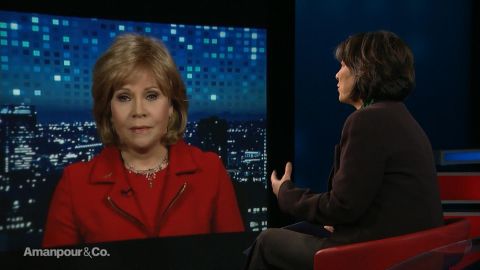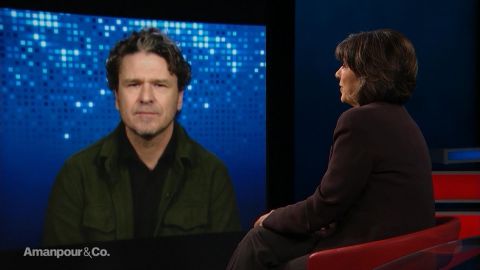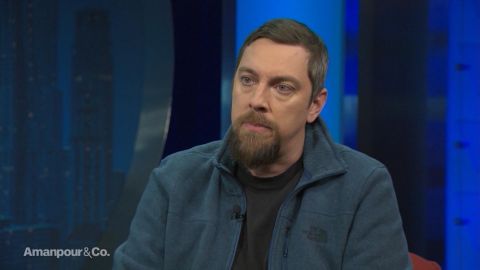Read Transcript EXPAND
CHRISTIANE AMANPOUR: Now, where were you when man first stepped on the moon? Everybody who watched has their own searing memory and they’re own story. Neil Armstrong setting foot out there and declaring, “One small step for man, one giant leap for mankind,” is the stuff movies and dreams are made of. But this very real heroic feat is the subject of a new documentary. Showing us that moment 50 years ago, this July in a whole new light. And here’s a clip from the trailer.
(BEGIN VIDEO)
UNIDENTIFIED MALE: The whole Apollo Program was designed to get two Americans to the lunar surface and back again to earth safely. The enormity of this event is something that only history will be able to judge.
(END VIDEO)
AMANPOUR: Todd Douglas Miller is the director of Apollo 11. He’s been speaking with our Hari Sreenivasan about it.
HARI SREENIVASAN: You know never before seen footage is often used as a marketing gimmick. But in this case it completely changed the composition of your film.
TODD DOUGLAS MILLER, DIRECTOR OF APOLLO 11: Yes, I mean initially — and this was the tail end of 2016, we cast a very wide net within the spider web network of NASA facilities and also the National Archives. And three or four months into the project we get this email from the National Archives, our contact there, our archivist who said that they had — had this collection of large format material that was previously, you know, uncataloged. They didn’t really know exactly what was on it. They had — it did have written on some of the reels, Apollo 11. Some of the dates ended around the launch, which was July 16th of 1969. So that began the process of discovering exactly what these were.
SREENIVASAN: How much footage are we talking about?
MILLER: So hundreds of reels. And it just wasn’t in National Archives. We also had access to another 100 reels of engineering 70 millimeter footage. So that’s all the great slow motion, you know, rocket — of the rocket taking off. We had a ton of that stuff to go through. And then if that wasn’t enough, we were also alerted to over 11,000 hours of mission control audio that was uncovered by NASA.
SREENIVASAN: How do you get 11,000 hours? I mean, what is – what are they recording for that long?
MILLER: So it was really unique. It was one inch tape. If you could imagine, if you’re sitting in mission control, you have 30 flight controllers. Each one of those guys that’s on a headset is recorded on a track in the back.
SREENIVASAN: So really, every word that was uttered in mission control had been recorded and sitting, gathering dust?
MILLER: Yes, and not only that. The backroom, each flight controller had an entire backroom full of other light controllers. So they were all on loops. So it was really, in essence, about 60 tracks that all needed to be synched up.
SREENIVASAN: But why take this on? I mean, at this point, we probably have a memory of seeing that black and white footage. Why – why do this as a film?
MILLER: You know, it really started as an editing exercise, you know, with my archive producer Stephen Slater who’s based in the U.K. He had been synching up a lot of mission control footage with audio because when they originally shot it, it didn’t have any sound on it. So, you know, it gets addictive, you know, to try to figure out what these guys are saying at what times because they really shot it with no regard for if, you know, there was going to be any audio. They were just kind of getting beauty shots of these guys working and documenting them for historical purposes.
SREENIVASAN: Yes.
MILLER: And once the large format stuff came into our purview, it felt like, you know, it – we were all, you know, wanting to work on something like this. So we were kind of – it was the perfect team for this to land on.
SREENIVASAN: So you find all this video – film and you find all this audio. What do you learn about this?
MILLER: We learned a lot. I mean, probably the greatest part of working on the project was working very closely with NASA’s chief historian, Bill Barry, and his team, obviously, the National Archives as well, and then the families and Buzz Aldrin and Michael Collins. Neil Armstrong’s sons, Rick and Mark, they were one of the first people that we showed this footage to before we even started the process of –
SREENIVASAN: What’d they think?
MILLER: I mean, they were floored like everyone else. You know, just when you thought you’d seen it all, and particularly for them. I mean, they – you know, they were so gracious with their time in helping us out to, you know, really get the accuracy of not only the mission but also just the spirit of who their fathers were and the people that worked with them.
SREENIVASAN: But what is it about this moment, I mean – which might not happen ever again, maybe until we set foot on Mars or the aliens come down and talk to us? It almost seemed to unite the entire planet.
MILLER: Yes. It was not lost on us at any time. I can speak for the entire team. It was just such a unique experience to – to witness the sheer scope of this. You know, you put yourself back in the `60s and with JFK in this charge to the country to try to drum up support for the space program, which is very expensive to send someone to another planet or another world. And all the political strife that was going on, you know, JFK himself, a year after his – his speech in Texas, is assassinated in Texas. His brother is assassinated. Dr. Martin Luther King is assassinated. You have the background of the Vietnam War, but throughout all of that, you have hundreds of thousands of people that are spread across tens of thousands of companies that all came together to accomplish this one goal of putting a human on another world. And it was – it’s just miraculous.
SREENIVASAN: And you’ve got a clip of that that I want to show as well. It starts with just kind of a long shot of how many people. It’s dizzying, even to think about it.
(BEGIN VIDEO CLIP)
UNIDENTIFIED MALE: We’re past the six-minute mark in our countdown for Apollo 11. Now, five minutes 52 seconds and counting.
UNIDENTIFIED MALE: (Inaudible).
UNIDENTIFIED MALE: (Inaudible). Verify go for launch.
UNIDENTIFIED MALE: (Inaudible). Verify go for launch.
UNIDENTIFIED MALE: (Inaudible). Verify go for launch.
UNIDENTIFIED MALE: (Inaudible). Verify go for launch.
(CROSSTALK)
UNIDENTIFIED MALE: We have some 7.6 million pounds of thrust pushing the vehicle upward. The vehicle weighs close to 6.5 million pounds.
(END VIDEO CLIP)
SREENIVASAN: That is a lot of people, and that’s just a clip from the film to illustrate your point. You know, one of the things that I remembered and I think most people nowadays, if – when they go to your film, what they’ll see is – well, the first shots you had of mission control, it was almost like it was a uniform. It was all white shirts, half-sleeve, with a tie, and almost all men. There was one woman in the room that really caught – I was like, “Wait a minute. What’s her story?”
MILLER: Yes. I mean, that’s the beauty of really doing the research and going deep into the archive with the entire Apollo program. There is one woman, her name is JoAnn Morgan. Apollo 11 was the first time that she actually was in the firing room which was the launch control center which was adjacent to the pad down in Florida what was called Cape Kennedy at the time now, today Cape Canaveral. And before the Saturn V rocket launched, she was just an amazing engineer. She was there on her own credentials, didn’t matter that she was a female. And she ended up having a very long history with NASA. Worked there for 43 years, retired and is still alive today. And it just wasn’t her. We had unfortunately and hopefully this ends up on like a Blu-ray or DVD. There was a 25 year old (inaudible) that was in the back room in mission control. Her name was Poppy Northcutt; she actually on Apollo 13 was in the front room. But there’s a moment after lunar liftoff when they’re arguing — the flight controllers in the front room are arguing over flight trajectories. So they consult with the back room. Poppy comes on, and basically just schools these guys in some math. And while their numbers are off and she’s trying to articulate why they’re wrong.
SREENIVASAN: Yes.
MILLER: And it takes about five minutes for her to finally get through to these guys. But it just highlights the great effort of all, just not male, female, minorities across all races to put this thing together.
SREENIVASAN: One thing that surprised me was relatively speaking how advance the technology in some way was. They were getting near real-time heart beats of these astronauts. And I had no idea that in 1969 we had the tech and then afterwards I was stunned by how low and how cool they are.
MILLER: Yes, I mean sometimes I have a tough time calling my sister back in Ohio. So, it’s just a testament to the technological advances that the Apollo program did. Certainly, if you listen to the air to ground transmissions, it’s scratchy most of th time. It’s tough stuff to get through. But they did it. And they developed ways to communicate. And that was just one of dozens of new technologies that were invented to put someone on the surface of the moon.
SREENIVASAN: At one point, at the takeoff I think, Buzz Aldrin’s heart beat is around 88. And then on the other end of the spectrum, Neil Armstrong’s heart beat when he’s about to land the thing is what, 100–
MILLER: 155.
SREENIVASAN: That is me on a treadmill at a good run, right? I mean that’s really exerting ourselves. And here he is, the stress of that moment, you could see it was in his heart right there.
MILLER: Yes, but when you listen to Neil Armstrong’s (inaudible) as they’re landing, it never waivers. So, he might’ve been stressing on the inside, but on the outside and it goes for all of the mission controllers during that moment. Charley Duke famously says, “Copy Eagle, you got a bunch of guys ready to turn blue here. We’re breathing again.”
SREENIVASAN: Yes.
MILLER: And it just goes to show kind of the nerves of steel. And you have to remember, Buzz and Neil both were Korean War veterans. They flew missions, dozens and dozens of combat missions. Buzz himself shot down a mig and then pulled out a camera and photographed the pilot ejecting. These guys had been hardened veterans of not only war but they were test pilots. And unlike some of their predecessors in the space program, they were educated. Neil had a degree in aeronautics. Buzz went to MIT. And they — his nickname was Dr. Randevu. Michael Collins was a graduate at West Point and ended up in the air force. So, these guys had been around the block. And it’s no — now you know why they were chosen to go about this extraordinary mission.
SREENIVASAN: And there was flying required back then. I mean the — we kind of take it for granted now. But to get these things to connect and disconnect and really ultimately landing of where the module landed was by hand.
MILLER: Yes. I mean, Neil Armstrong certainly they had very archaic computers compared to now. But to get them to a certain altitude and then Neil actually — Neil Armstrong himself guided the lunar lander down to the surface of the moon.
SREENIVASAN: Going through all this footage, what surprised you?
MILLER: I think if you see the suiting up shots that was the most surprising for me. I had seen those images a lot over the decades. But I had never seen them like that. And just opposed a real that came shortly after we had that real which from the day of the launch, the morning of the launch. They’re getting suited up to go on this amazing thing — journey. There was — they were doing the same thing a few days before on a dry run. And they were kind of slapping themselves on the back. A bit jovial. You know they did the same thing. They went into the astrovan, drove out to the pad, got in the elevator, went — sat on top of the rocket, came back down and went home. But on the day of the launch, you just see this look on their faces. There was no joking and you could just see the weight of what they were about to do written all over it. And it just really snapped into focus, I think for all of us. Their responsibility that they had to do that and also, you know in a very small way, our responsibility, you know to the imagery that we were luckily enough to be granted to work with.
SREENIVASAN: I didn’t realize one of the first things that happened on the moon was to set up a camera. I mean just like well there’s scientific gear, et cetera, et cetera. Actually he sets up the camera and you can see all of these shots of Buzz Aldrin coming down. I mean it was just — there’s certainly forethought put in to what they should do and how it should be documented for the entire world to see.
MILLER: Yes, the training was immense. They — you know they rehearsed down to the second exactly all the moves, choreographed. One of the kind of humorous things was when they landed they were actually supposed to sleep. They were supposed to have a sleep period. But of course you land on the moon and I don’t think anybody’s going — anybody’s going to go to bed. So they requested if they could, you know, perform their lunar excursion activities, the EVA first. They were granted that. And some of that imagery that we saw, you know at first, quite frankly the engineers at Goldstone, California weren’t ready for it. So that’s why the image is flipped upside down. There wasn’t — you know originally it was supposed to go to Australia and just the way that signal was, you know, sent to the earth it ended up at California. So, you know, luckily we do have that imagery and lucky, you know, for me as a film maker, Buzz Aldrin documented with a 16 millimeter camera looking right down the barrel of the later, Neil’s first steps.
SREENIVASAN: Just suppose that capsule with what just happened a little awhile ago, SpaceX sending a capsule up, I mean you look around and every shot Buzz Aldrin — the Armstrong, there’s just switches and gear and buttons and lights everywhere. And now it’s this clean white wall, two LED screens. I mean it’s amazing that these three humans had to know how to work all of that manually.
MILLER: What we’ve accomplished in 50 years, you know on the technology front, I think is — is truly amazing and I’m — I’m actually encouraged that you know companies like SpaceX working with NASA and all the great, you know, space programs all around the world, it’s a very exciting time for the future of space travel because we’re going to have to get out there, you know, at some point.
SREENIVASAN: Why doesn’t the government undertake anything like this? Could it? Should it? Is it going to be replaced by private companies and is that the right way to get going in space?
MILLER: I could speak to the historical context, which is — you know John F. Kennedy made a charge to the country and — and — and went out and actually sold this. So there was a political will that was established to make this happen. Our legacy of Apollo, I think should be followed up. It’s inevitable. You know we’re — as we grow as a population worldwide where we need, you know, new places to go. Whether it happens, you know, a hundred years from now, a thousand, a million; it’s going to happen. And Apollo 11 serves as a — the entire program serves as a — as a primer for us to — to get back out there.
SREENIVASAN: Is that what you want people to take away from the film?
MILLER: I think so but also just to be reminded that over the decades and as time has evolved, you know we — we kind of get into our boxes, if you will, and events like this bring us together. They unite us and they certainly did back then and they certainly can do again.
SREENIVASAN: Thanks so much for joining us.
MILLER: Thanks for having me.
About This Episode EXPAND
Christiane Amanpour speaks with David Beasley and Mary Schiavo about the fatal plane crash in Ethiopia; and Dave Eggers about his new book, “The Parade.” Hari Sreenivasan speaks with Todd Douglas Miller about “Apollo 11,” his new documentary that chronicles the moment Neil Armstrong set foot on the moon.
LEARN MORE


